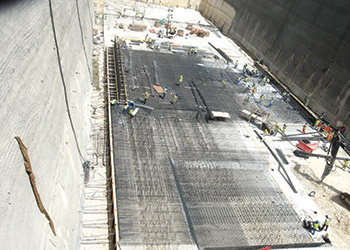
Chemicals specialist Sika’s latest innovation for structural waterproofing is a fully bonded, highly flexible membrane system, designed to be used for basement waterproofing on new constructions and for renovation work.
Called SikaProof A and launched late last year in the GCC, the fully bonded, highly flexible membrane system is applied before installation of steel reinforcement and before the fresh concrete is poured.
This new product combines Sika’s knowledge and expertise from the construction and automotive businesses, namely Sikaplan FPO membrane and Sikamelt sealants.
SikaProof A is a waterproofing membrane system that clearly differentiates from traditional solutions, the company says.
The membrane surface is embossed with a grid pattern, which contains a sealant and is topped by a thin layer of fleece. In contrast to existing membrane systems, SikaProof A is fully bonded to the cured concrete, with its layer of specially designed fleece forming a mechanical bond after hardening of the structural concrete. This mechanical key is not influenced by high temperatures during the construction process unlike normally adhered systems which can peel off when exposed to sunlight, it adds.
The sealant in a grid pattern forms “mini” watertight compartments which limits the water underflow if the membrane is damaged or punctured. Because of this sealant grid, moisture or pressured water cannot pass between the membrane and the concrete structure. Compare to non-fully bonded systems, the risk of leaks in basement is strongly reduced due to limited area of potential water migration.
Another major advantage is in the way that the individual sheets of the membranes are connected to each other. Instead of time-consuming and complicated welding – the procedure normally used to connect loose laid membrane sheets – SikaProof A sheets are joined using either the adhesive strip which runs along the longitudinal edge of every sheet or by fastening them together with specially designed self-adhesive tapes.
This quick and easy system for adhering sheets is also very cost-effective as it increases dramatically the speed of application and eliminates the need for expensive welding machinery, says Sika.
Meanwhile, Sika has revealed that its sustainability strategy, whose avowed aim is “More Value – Less Impact”, has got off to a successful start, with the company exceeding most of its targets for 2014.
The G4 Guidelines of the Global Reporting Initiative (GRI G4) have provided the framework for sustainability reporting since 2013. Sika measured its performance against the new sustainability targets for the first time in 2014 and revealed it lowered energy and water consumption per tonne sold by an impressive 12 per cent and 10 per cent per annum respectively, beating the target of 3 per cent by a substantial amount.
A new process was introduced to assess all sustainability aspects of new product developments over their lifecycle.
Major Sika organisations worldwide also developed local product sustainability roadmaps tailored to local demand and in line with the global approach.





















_0001.jpg)


.jpg)
















.jpg)








.jpg)


